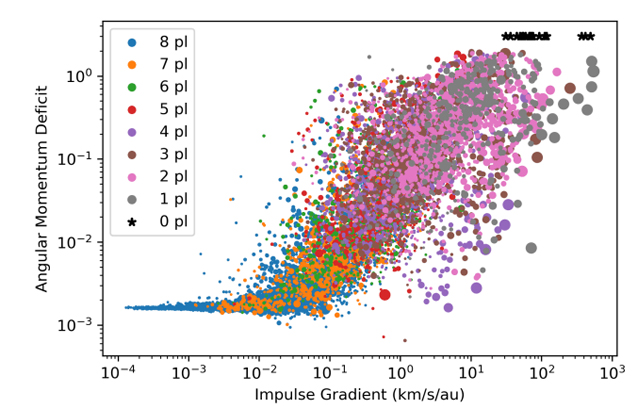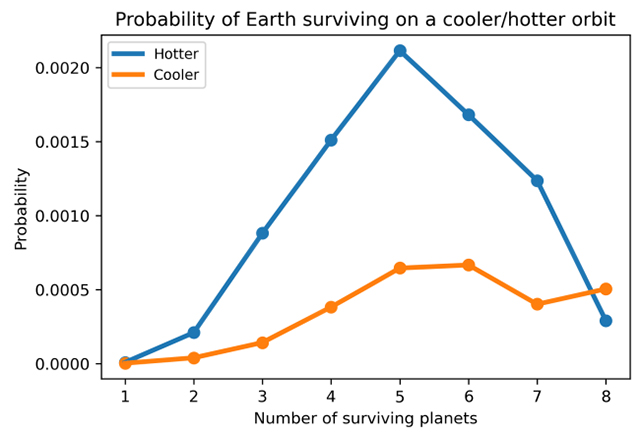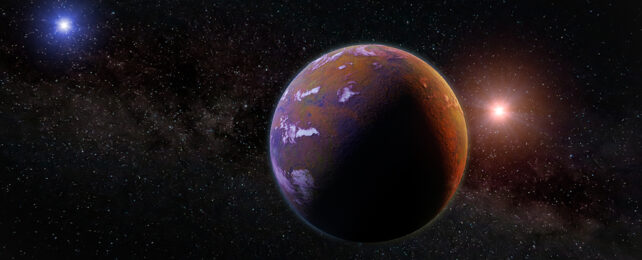Stars are gravitationally fastened to their galaxies and move in concert with their surroundings. But sometimes, something breaks the bond. If a star gets too close to a supermassive black hole, for example, the black hole can expel it out into space as a rogue star.
What would happen to Earth if one of these stellar interlopers got too close?
It's not a very likely occurrence, but the chance is not zero.
After several billion years, our Solar System has evolved into sedentary predictability. The planets move as they move, and the Sun sits stolidly in the middle of it all.
But if another star came too close, the invisible gravitational bonds that keep everything going the way it is would be stretched or broken.
Earth is a tiny planet, containing only about three millionths the mass of the Sun. Our planet exists at the whims of the Sun and its powerful gravity, and if another star shoulders its way into our tidy arrangement, Earth will be entirely at the mercy of the new gravitational paradigm.
A new paper examines what would happen if a rogue star comes to within 100 AU of the Sun. The paper's title is "Future Trajectories of the Solar System: Dynamical Simulations of Stellar Encounters Within 100 au." It'll be published in Monthly Notices of the Royal Astronomical Society. The lead author is Sean Raymond, an astronomer at the Laboratoire d'Astrophysique de Bordeaux, CNRS (National Center for Scientific Research) and the Université de Bordeaux.
We know that the stable predictability in our Solar System will not last. The Sun will continue to evolve and, over the next billion years, will become more luminous. Earth is awfully close to the inner edge of the habitable zone. Only a little closer to the Sun and the delicate balance that allows liquid water to persist on the surface will be disrupted.
In that same one billion year range, there's about a 1 percent chance for an encounter with a rogue star. What will happen to Earth if that happens? Will Earth be nudged out of the habitable zone?
"Earth has about a billion years of habitable surface conditions remaining," the authors write. That's in a closed system, which, for the most part, our Solar System is.
"While the orbital evolution of the planets is largely determined by secular and resonant perturbations," the authors explain, "passing stars can have a consequential influence on the planets' orbits."
If a passing star comes to close, then our Solar System is no longer a closed system.
Most rogue stars, also called intergalactic stars or hypervelocity stars because their trajectories will take them out of the Milky Way, come nowhere near Earth. Kappa Cassiopeiae, for example, is 4,000 light-years away and will never approach. Others, like the 675 rogue stars astronomers at Vanderbilt University discovered in 2012, were ejected after tangling with the Milky Way's supermassive black hole, and their trajectories brought them nowhere near Earth.
Even in the Milky Way, space is mostly empty, and most stellar flybys will never approach another solar system.
"Statistically speaking, flybys closer than 100 au, which would strongly affect the planets' orbits, only take place roughly once per 100 Gyr in the current Galactic neighbourhood," the researchers explain.
Though the odds are low, it's a possibility. When you look at the galaxy as a whole, it's almost certain that a stellar flyby sometime somewhere in the galaxy will come within 100 AU of another star.
If that star is our Sun, what will happen to Earth?
The team performed N-body simulations to try to determine the potential outcomes for Earth. They started with the Solar System's eight planets and added a single rogue star. They matched the masses of the simulated rogue stars to the masses of stars in our stellar neighbourhood. They also matched the rogue stars' velocities to the neighbourhood. They simulated different velocities and trajectories for the star to see what the range of outcomes for Earth looks like. In total, the researchers ran 12,000 simulations.

"If a star passes within 100 au of the Sun, there is still a very high chance that all eight Solar System planets will survive," the authors write. There's over a 95 percent chance that no planets will be lost.
The angular momentum deficit (AMD) as a result of the flyby largely determines what happens next. AMD is a measure of a planetary system's orbital excitation and its long-term stability. It's the difference between an "idealized system with the same planets of the real system orbiting at the same semimajor axes from the star on circular and planar orbits and the norm of the angular momentum of the real planetary system," according to this definition.
But what does it look like when one of our Solar System's planets is lost?
The simulation produced diverse outcomes. Mercury is the most vulnerable and is sometimes lost when it collides with the Sun. Other results include Earth colliding with Venus, ejection of the ice giants Uranus and Neptune, only Earth and Jupiter surviving, or only Jupiter surviving. In one apocalyptic outcome, all eight planets are ejected.
Other results are less dramatic. All eight planets are unperturbed, all eight are slightly perturbed, or all eight are highly perturbed.
Though all eight planets survive in most of the simulations, survival can mean different things. Even though they remain in the Solar System and remain gravitationally bound to the Sun, their orbits can be wildly disrupted. Some can even be shoved way out into the Oort Cloud.
The researchers also tabulated the ten most likely outcomes where planets are destroyed.
"We determined the most common pathways through which planets may be lost, keeping in mind that there is a greater than or equal to 95 percent chance that no planet will be lost if a star passes within 100 au," they write.
- Mercury collides with the Sun (probability of 2.54%).
- Mars collides with the Sun (1.21%).
- Venus impacts another planet (1.17%).
- Uranus is ejected (1.06%).
- Neptune is ejected (0.81%).
- Mercury impacts another planet (0.80%).
- Earth impacts another planet (0.48%).
- Saturn is ejected (0.32%).
- Mars impacts another planet (0.27%).
- Earth collides with the Sun (0.24%).
When it comes to ejected planets, Uranus and Neptune face the worst odds. That's not surprising since they're furthest from the Sun and most weakly bound to it gravitationally. It's also not surprising that Mercury has the highest odds of colliding with the Sun. As the least massive planet, it faces a greater risk of perturbation due to a stellar flyby.
When it comes to Earth, there are a wide variety of potential outcomes. In the list above, Earth has a 0.48 percent chance of colliding with another planet. But another potential fate awaits Earth, and it's not pleasant to contemplate: banishment to the Oort Cloud.
"The long-term survival of Earth in the Oort cloud is not guaranteed," the authors deadpanned.
Another exotic outcome of the simulations is worth considering: Earth's capture by the passing star. That simulation had a star slightly less massive than the Sun and travelling at a relatively low speed approaching our Solar System closely.
The outcome was a devastating annihilation of the Solar System as we know it. Earth abandoned the Sun and ran off with the star, while six of the other planets crashed into the Sun. The lone surviving planet was Jupiter. No surprise there since it's the most massive planet.
The paper presents a wide range of outcomes, including the Moon impacting Earth, both the Earth and Moon being captured by the passing star, and even all of the planets and their moons being destroyed. But the odds of any of this happening are extremely low.
But how likely is it that Earth would remain habitable in such an encounter? If Earth's orbit is changed, then the planet will be warmer or cooler as a result.

There are yet more potential fates. Earth could survive as a rogue planet for a million years or so until the surface froze over. Or maybe if it did get captured by the rogue star, it would somehow be habitable in some new arrangement.
Ultimately, the odds of a 100 AU stellar flyby are infinitesimally small. And the simulations show that if it did happen, the most likely outcome by far is that all eight planets survive, albeit in orbits slightly different than the ones they follow now.
"Despite the diversity of potential evolutionary pathways, the odds are high that our Solar System's current situation will not change," the authors conclude.
This article was originally published by Universe Today. Read the original article.
